ADSR Envelope Generator (+/-12V or +/-15V)
Article by Ray Wilson
Back to "Music From Outer Space" Analog Synth Pages
Features
- 1 mS to 20 second Attack, Decay, and Release times.
- Classic ADSR envelope shape and functionality.
- Gate and trigger inputs permit retrigger after Attack complete.
- Comparators on gate and trigger inputs.
- Power Supply Range +/-9V up to +/-15V
|
Introduction
Envelope generators provide a source of voltage that is shaped like a
common amplitude envelope. The gate input is used to initiate the
ADSR envelope. The following assumes the gate is maintained throughout the
attack, decay and sustain cycles.
The voltage envelope rises from 0V to 10 volts during the attack cycle at the
rate set by the Attack control. At the peak of the attack cycle (10 volts) the
decay cycle is entered. The voltage decays to the sustain level (0 to 10 volts
dependant on the setting of the Sustain control) at the rate determined by
the Decay control. When the gate is released the release cycle is entered and
the voltage decays to 0 at the rate determined by the Release control setting.
If the gate is removed at any time during the A,D or S cycle the release state
is immediately entered. The trigger input used alone can initiate an attack
release cycle. When used in conjunction with the gate the trigger can re-initiate
an attack cycle when it occurs during the decay or sustain cycles.
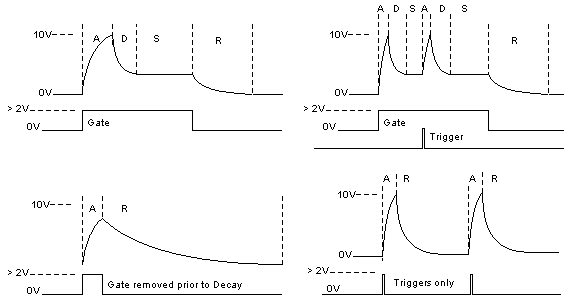
This is an intermediate to advanced project and I do not recommend it
as a first project if you are just getting started in synths or electronics.
Only the circuit and some explanation is shown here. A lot of project building experience and electronics
knowledge and equipment ownership (scope, meters, etc.) is taken for granted.
If you are interested in building this project please read the entire page before
ordering PC boards to ensure that the information provided is thorough enough for you to complete the project.
Buy ADSR Envelope Generator PC Boards
|
Tired of etchant eating your hands and the tedious work of drilling hundreds of
tiny holes. Tired of that tingly guilty feeling you get as you flush ferric
chloride into the environment. Then buy a ready-to-go, super high quality PC
Board! You can feel good because I get my boards from an environmentally
responsible manufacturer!
Purchase Printed Circuit Boards online! Click the Add To Cart button to
make a purchase or go to PayPal
to sign up for a PayPal account. You can also set the number of boards you
would like to buy on the PayPal shopping cart page.
Please note that you are buying an un-populated PC board
only. The glass epoxy, double sided, plated through-hole PC board is
professionally manufactured, pre-drilled and silk-screened with a parts layout
legend. You must purchase all of the parts for the project and build it
yourself. But since that is the whole idea behind DIY (Do It Yourself) that's a
good thing.
|
|
ADSR Envelope Generator PC Board (4.5" x 2.5")
|
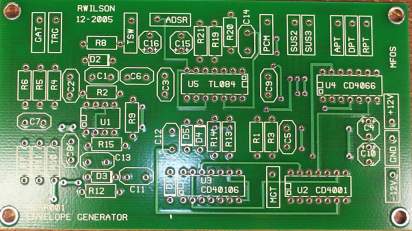

|
Purchase ADSR Envelope Generator PC Boards via PayPal
|
|
(1) ADSR Envelope Generator PC Board $12.50
|
|
|
|
|
There is a $4.00 Shipping and Handling fee on all orders. Most people get their
boards within a week but... Please allow three weeks for delivery within the
United States and four to five weeks for destinations outside of the United
States.
|
ADSR Envelope Generator Page 1 PDF
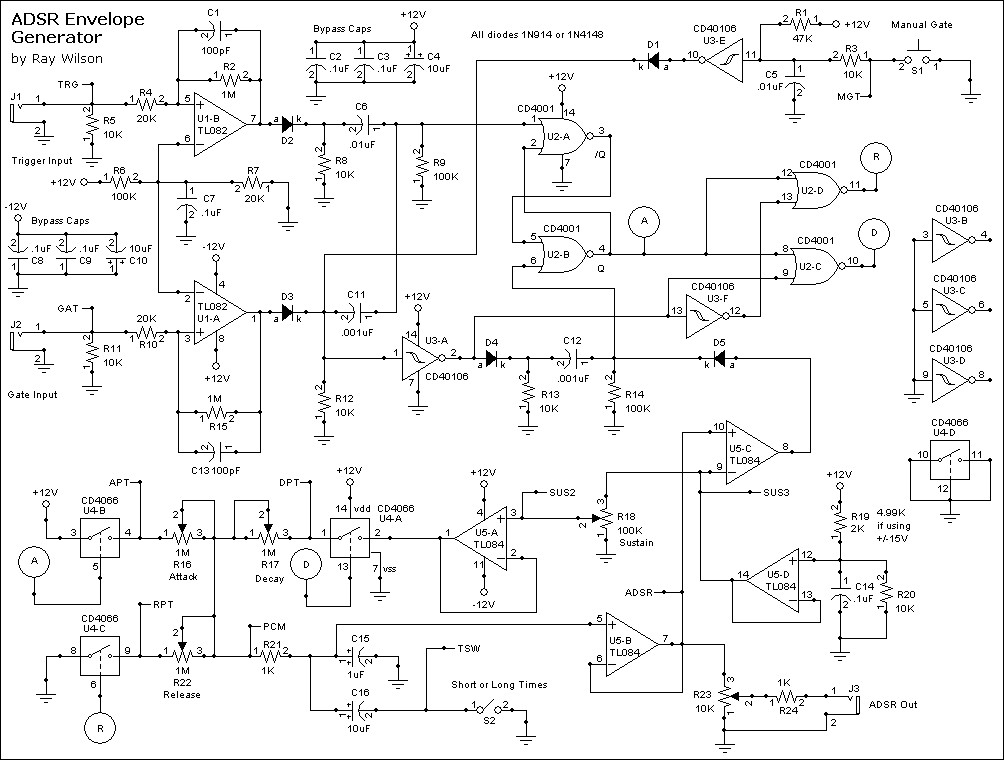
|
With gate and trigger inputs at 0V the circuit is at its quiescent state. Point R is
high in this state because both inputs of U2-D are low. Point R being high causes analog
switch U4-C to be on which discharges C15 to ground via the Release pot's resistance setting.
When the gate input is brought slightly above 2 volts the comparator comprised of
U1-A and associated components goes from -V to +V very quickly. This pushes current
through C11 and drops a high going spike across R9. The spike across R9 causes
the flip-flop comprised of U2-A and U2-B to output a high logic level on pin 4 of U2-B.
This high level turns off analog switch U4-C and turns on analog switch U4-B which begins to charge C15 (or
C15 and C16 in parallel if S2 is closed) toward V+. The voltage on C15 is sensed by
U5-C which acts as a comparator with a threshold of 10 volts. When C15 charges to 10 volts
U5-C's output goes from -V to +V very quickly. The positive excursion of the output of U5-C
(pin 8) is fed to the input of U2-B via D5 and causes the flip-flop comprised of U2-A and U2-B to
output a low logic level on pin 4 of U2-B. The presence of the gate keeps U2-D's output low
but also allows U2-C's output to go high turning on U4-A which allows C15 to discharge to the
level of U5-A's output (which is determined by the sustain pot setting). When the gate is released
C15 is discharged to ground at the rate set by the Release pot when analog switch U4-C closes.
If the gate is applied and release before the decay cycle the output of U3-A goes high and resets the
flip-flop comprised of U2-A and U2-B so that the release phase is entered immediately.
Application of trigger pulses (along with the gate present) after the attack phase has completed
sets the flip flop and starts the attack cycle over again. Application of trigger pulses
(without the gate present) results in a complete attack phase followed by the release phase.
|
ADSR Envelope Generator PCB Parts Layout (Parts Side Shown)
PDF
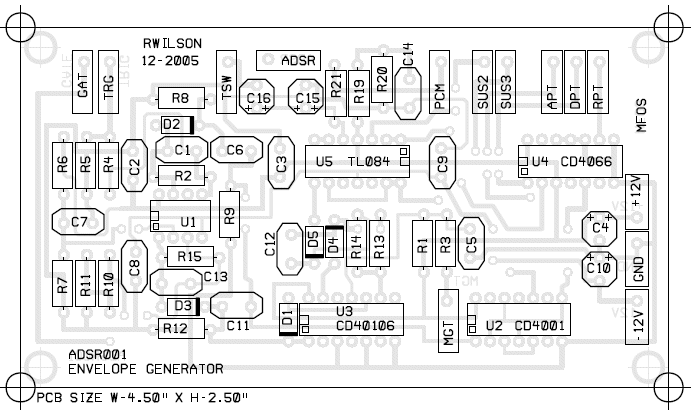
ADSR Envelope Generator PCB Bottom Copper (Parts Side Shown)
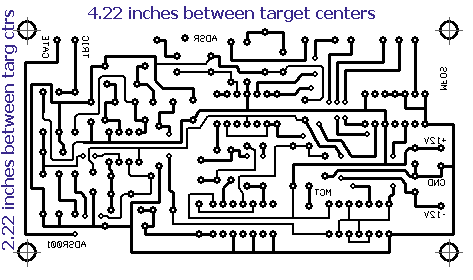
ADSR Envelope Generator PCB Top Copper(Parts Side Shown)
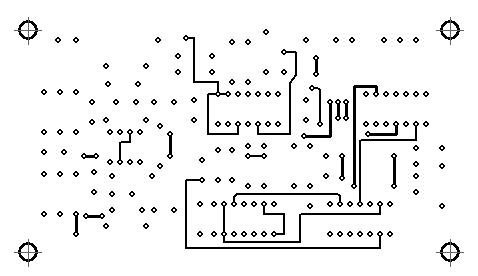
ADSR Envelope Generator PCB Top Silk Screen

ADSR Envelope Generator Front Panel Suggestion PDF
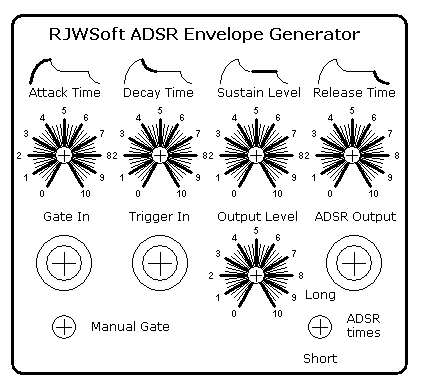
ADSR Envelope Generator Front Panel Wiring PDF
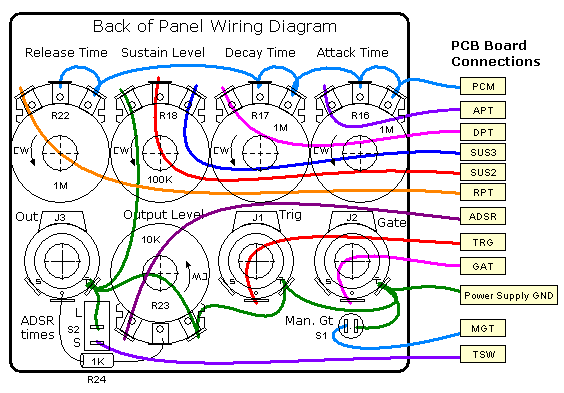
ADSR Envelope Generator During Testing Larger Shot
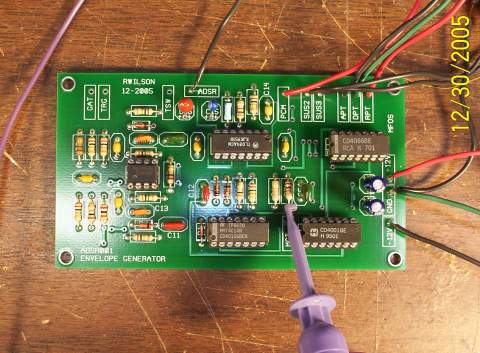
ADSR Envelope Generator Project Parts List
| Qty. | Description | Value | Designators |
|---|
| 1 | CD4001 Quad NOR | CD4001 | U2 |
| 1 | CD40106 Hex Schmitt Trigger | CD40106 | U3 |
| 1 | CD4066 Quad Analog Sw. | CD4066 | U4 |
| 1 | TL082 Dual Op Amp | TL082 | U1 |
| 1 | TL084 Quad Op Amp | TL084 | U5 |
| 5 | 1N914 or 1N4148 Diode | VALUE | D2, D4, D5, D3, D1 |
| 2 | Ceramic Capacitor(s) | .001uF | C11, C12 |
| 2 | Ceramic Capacitor(s) | .01uF | C5, C6 |
| 6 | Ceramic Capacitor(s) | .1uF | C14, C7, C2, C8, C9, C3 |
| 2 | Ceramic Capacitor(s) | 100pF | C1, C13 |
| 2 | Electrolytic Capacitor(s) | 10uF | C4, C10 |
| 1 | Electrolytic Capacitor Tant. | 10uF | C16 |
| 1 | Electrolytic Capacitor Tant. | 1uF | C15 |
| 1 | Potentiometer | 100K | R18 |
| 1 | Potentiometer | 10K | R23 |
| 3 | Potentiometer(s) Log Taper | 1M | R16, R22, R17 |
| 3 | Resistor 1/4 Watt 5%(s) | 100K | R14, R6, R9 |
| 7 | Resistor 1/4 Watt 5%(s) | 10K | R5, R8, R13, R12, R3, R20, R11 |
| 2 | Resistor 1/4 Watt 5%(s) | 1K | R21, R24 |
| 2 | Resistor 1/4 Watt 5%(s) | 1M | R2, R15 |
| 3 | Resistor 1/4 Watt 5%(s) | 20K | R4, R10, R7 |
| 1 | Resistor 1/4 Watt 5% | 2K | R19 |
| 1 | Resistor 1/4 Watt 5% | 47K | R1 |
| 1 | SPST PB Switch | SPST | S1 |
| 1 | SPST Switch | SPST | S2 |
| 3 | Jack (2 Conductor) | Jack | J1, J2, J3 |
Miscellaneous
-
(1) 4" x 10" 1/16" thick Aluminum plate for mounting the pots and
switches.
-
Unit is typically mounted in a synth case with other synth modules.
-
Assorted hardware 1" 6-32 nuts and bolts, 1/2" #8 wood screws, etc
-
Knobs for potentiometers, wire, solder and typical assorted electronics hand
tools.
-
Digital Volt Meter and a Signal Tracer or oscilloscope for testing.
All Content Copyright Ray Wilson and RJWSoft 2006
|







